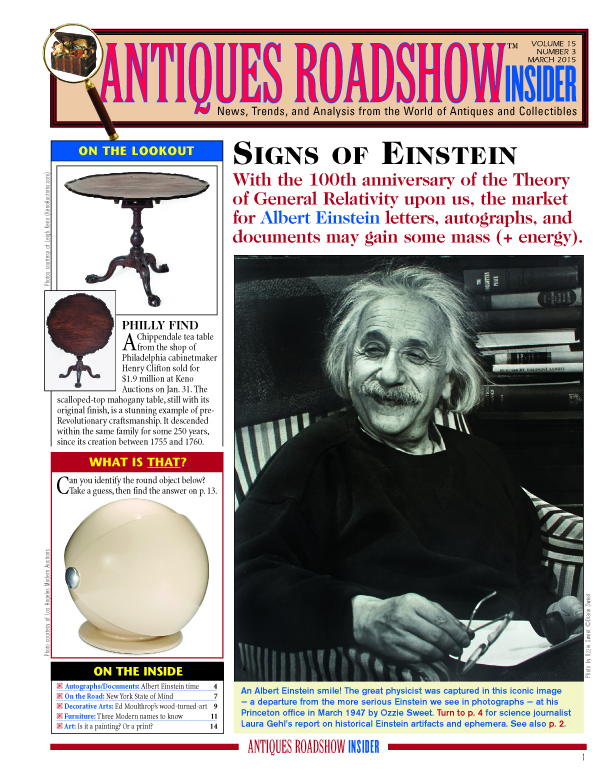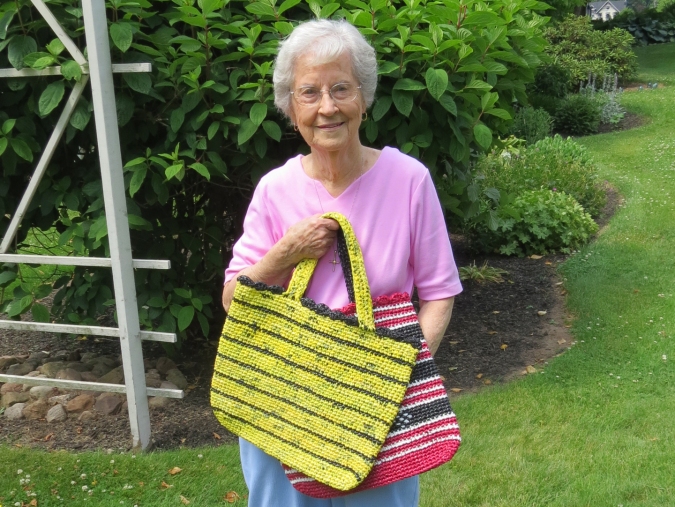One of the best parts of editing a publication is going through correspondence sent in by readers, whether they’re complimenting, criticizing, or simply commenting. Along those lines, I just received a letter that instantly became one of my all-time favorites.
Here’s the set-up: Our March 2015 issue featured a cover story on Albert Einstein mementos and documents by author Laura Gehl. The cover photo: a rare smiling portrait of a completely disarmed Einstein. As I wrote in my column in the same issue (and expanded upon in my Feb. 10 entry here), Ozzie Sweet took the portrait in 1947 at Princeton University, and he clearly had Prof. Einstein feeling at ease. You just don’t see many photographs of him with such an honest, comfortable smile.
The Einstein image and coverage inspired some amazingly clear memories from reader Carole Hemingway. As a young girl in New Jersey, she met Albert Einstein and wound up visiting him on several occasions. Her description of his demeanor and his gentleness go a long way in humanizing the great physicist. It’s worth reading:
“After a friend of mine bought me a subscription to Insider as a gift, I got your March issue, with Albert Einstein featured in the cover story and in ‘The First Word.’ I read the sentence, ‘How often do you get to know someone who stood face to face with Albert Einstein?’ and I thought, I did!
“I was living in New Jersey at the time, and I was 9 or 10 years old. My science teacher, whom I adored, had polio, and walking wasn’t easy for her. The other kids used to make fun of her, but I stayed after school and washed the blackboards. I learned a lot from Mrs. Stein; she had a unique way of teaching science—it was like storytelling. She made it interesting.
“One day she asked me if I’d like to go and meet a dear friend of hers. She said my mother would have to sign a permission slip, and she did. So on a Saturday, we pulled up to 112 Mercer St. in Princeton, and I got nervous. Yep, it was him: Albert Einstein. It was a fall day, I smelled wood smoke, and the air was crisp. I was introduced to “the man,” and he took my hand and kissed it. I knew I was never going to be the same again.
“I sat in a corner on a couch by the fireplace playing with one of his cats while Mrs. Strein talked to him. Then he came over to me, knelt beside me, and said, ‘Child, come and join us in conversation,’ to which I responded, ‘I’m a kid; what could I possibly have in common with you?’ He answered, ‘Can you swim?’ to which I replied, ‘No.’ He said, ‘Neither can I. Let’s talk; I’m sure we will find other common ground.’
“Well, that started several years of visits and lots of warm and funny conversations between us. We sailed in his leaky boat and bailed out a lot of water, and his housekeeper would come out on the lawn screaming in German because neither of us wore life preservers — our code for bravery, I guess. I watched him deliver a litter of kittens to a mother cat that otherwise would have died. And he had the first herb garden, before we knew what they were. When I asked him if he liked living in Princeton, he joked, ‘The people here should be put in mason’s jars, with holes poked in the top so they could breathe, so I could observe them.’
“He was a gentle man, a kind man, and he allowed me to call him ‘Uncle Al.’ And I simply adored him. These are just a few of the memories of Albert Einstein that I have. There are others, too. And as I read the articles in your magazine, I thought, ‘Here’s all this memorabilia going for hundreds of thousands of dollars, but I had a real relationship with Albert Einstein.’ Try putting that on the auction block!”

A bidder at Sotheby’s in London may have paid $84,976 for this pair of Albert Einstein handprints, but Insider reader Carole Hemingway has her own priceless Einstein “memento” — her recollections of a series of visits with him while she was growing up. (About these prints above: A hand-reader named Marianne Raschig made them in 1930 and included them in a book of handprints she compiled.)





